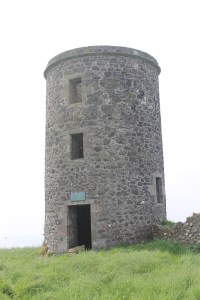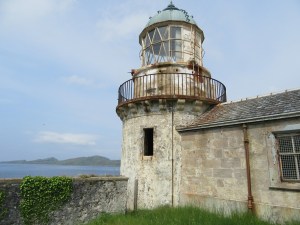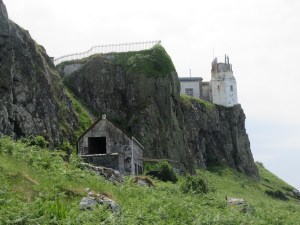At the weekend we spent some time in Ayrshire and, thanks to our friend Rick, we went on a fantastic trip over to Little Cumbrae (also know locally as Wee Cumbrae). It’s always exciting to visit a small island with more than one lighthouse – sort of like visiting the Calf of Man. It’s always a treat. Wee Cumbrae is particularly special though in that it has three generations of lights.

The ride over to the island in a RIB was very short and uneventful, which made a nice change! After saying goodbye to our chauffeurs and their very excitable dog, we began making our way towards the island high point, which was of interest to us all. For me it was to see the island’s oldest lighthouse, while the rest were keen to reach the high point in order to legitimately say they had bagged the island. There was a nice path most of the way to the high point, but as we got closer it became apparent that we would need to go off piste, so we cut across the grass, ferns and various other types of foliage.
We finally reached the old lighthouse and explored the remains. The tower was originally built in 1757 and, according to Canmore, was a 30ft tower with 3ft thick walls. The coal for the light was supported by an iron cage or grate. From inside the tower it is still possible to see where steps up the light used to be and, to the north of the tower, are the remains of the old keeper’s cottage. Less than 40 years after it was first lit, the lighthouse was replaced. From the lighthouse it was just a short walk to the island high point.

Our next destination was the second of the island’s lighthouses, first lit by the Cumbrae Lighthouse Trust with funds generated from the shipping dues from the old lighthouse. The lighthouse was designed by Thomas Smith, the first Northern Lighthouse Board’s engineers, and its construction was overseen by Robert Stevenson, the first of the “Lighthouse Stevensons”. The lighthouse is a fascinating place to visit now that it is no longer operational. The tower, all of the keeper’s cottages and associated buildings are now open so you can have a good look around. We were pleased to be able to get right to the top of the lighthouse and there is still a distinct smell of mercury about the tower. The keeper’s cottages are home to an interesting array of relics, including some 1970s editions of Reader’s Digest and, oddly, a few sets of old airplane seats. We spent quite some time exploring the buildings and everyone seemed to enjoy it.

Located close to the lighthouse was the old fog horn control room and tower, upon which the operational beacon now sits. By this point the sun had come out and we enjoyed lunch near the lighthouse, explored the old pier area which was clearly where access to the lighthouse from the sea had previously been, and then headed back across the island.
When we arrived back at our drop-off point we still had a fair amount of time left before we were picked up so a few members of the group wandered across to Castle Island, a very short distance off of the east coast of the island. When I say “wandered” what I mean is that, initially, the group used various methods of getting across the fairly shallow stretch of water. Bob was first across and just waded his way through with his shoes on and everything. The next three sensibly removed their shoes and paddled across. As the tide continued to recede, the next two or three people threw rocks into the water to use as stepping stones for getting across. By the time most of the group had crossed, the water had gone down enough for me to just stroll over to the island without getting wet feet at all.

Castle Island is so called due to the beautifully preserved lighthouse which sits upon it. Apparently dating back to the 16th century, there is now a set of wooden steps leading up to the castle entrance. There are some fantastic rooms in the castle, some of which contain some wooden tables and benches. The views from the top, where more benches can be found, are stunning. We spent quite some time up there. By the time we returned from Castle Island the tide was fully out and the crossing was dry.
We spent the remainder of our time on the island looking around the grounds of the yoga and meditation centre. A really well-kept garden and definitely a good island for some relaxation. It was a great island and I was pleased to be able to bag two new lighthouses there 🙂

I’d love to visit little Cumbrae lighthouse because my father was one of the three keepers there around 1954 and I lived there when I was 5 year’s old!
Hi Frieda. Thanks so much for commenting. That must have been a fantastic island to live on as a child. So much to explore. There is a boat operator based in Largs who I’ve been over there with twice: https://www.ccmarine.co.uk/ (you don’t have to do the diving bit)!
My grandmother Louise Caroline Mclean wa born on 9th August 1878 on Little Cunbrae. My great grandfather was the lighthouse keeper James Alexander Mclean. I would love to find any further information for my Family Tree if any is avaiable. Also details of how my family could visit. I am now in my eighties.
Thank you for any information .
We share the same grandparents.please contact me
That’s my grandfather so we must be related.please contact me
I spent a few days on Little Cumbrae in the late 1960s, visiting my aunt Mary and her husband (Archie?), one of the lighthouse keepers. In winter they were cut off for days at the time.